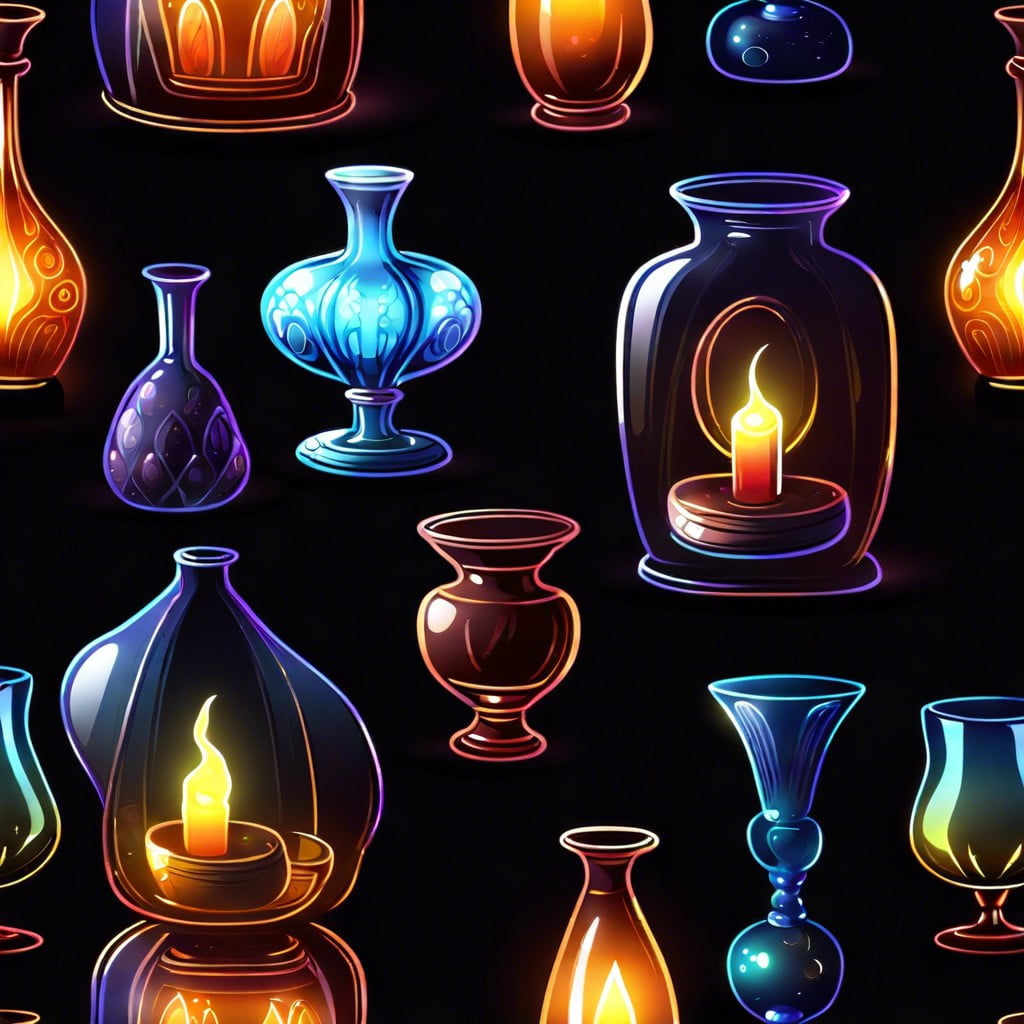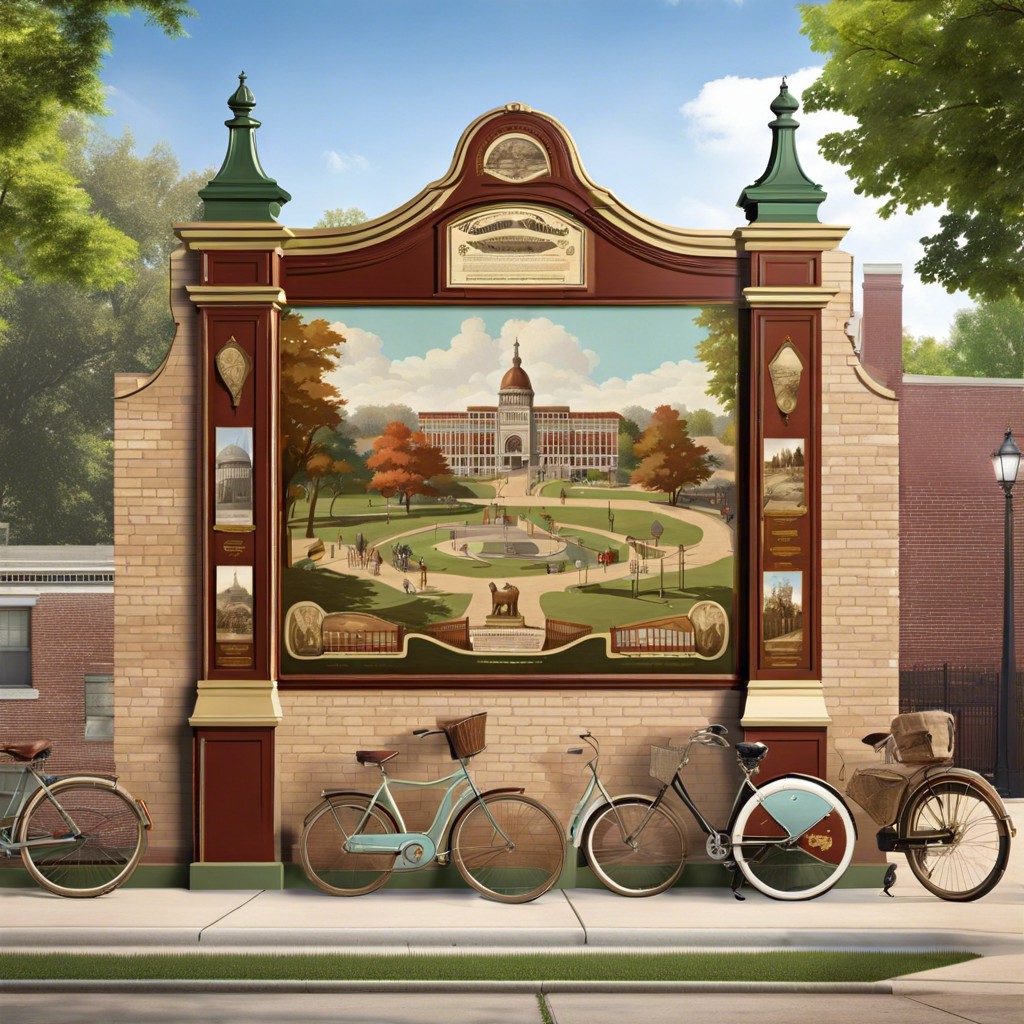Last updated on
Dive into the fascinating world of uranium glass, an irresistible antique collectible that glows under ultraviolet light, because its intriguing history and unique properties promise to captivate anyone with an interest in art, history, or science.
Key takeaways:
- Uranium glass comes in different types: phosphorescent, fluorescent, electroluminescent, and neon glass.
- Uranium glass gets its green glow from uranium dioxide.
- UV light is used to identify uranium glass.
- Vaseline glass is similar but has a yellow hue.
- The value of uranium glass varies based on factors like age, condition, and rarity.
Different Types of Glowing Glass

Glowing glass captivates with its radiant beauty and variety. Among the most popular types is phosphorescent glass, which absorbs light energy and later releases it in the dark. Another intriguing category is fluorescent glass, which emits a bright glow under ultraviolet light due to substances like europium or manganese. Electroluminescent glass, on the other hand, requires an electrical charge to produce its luminous effect. Artisans also create handblown neon glass by infusing gaseous elements that light up in electrically charged environments. These glowing glass types are incorporated into a myriad of objects from decorative art to practical household items, each offering a unique allure that transforms their surroundings with light.
What Is Uranium Glass?

Uranium glass, a subtype of glassware, gains its characteristic coloration and glow from the incorporation of uranium dioxide during the glass-making process. This additive bestows a fluorescent quality, particularly under ultraviolet light, where it displays a bright green glow. The intensity of the color and glow varies according to the concentration of uranium and the presence of other additives.
Typically, this hue ranges from yellow to green, leading to the moniker “Vaseline glass” due to its resemblance to petroleum jelly in some instances. Beyond its visual allure, uranium glass has a historical pedigree, dating back to the 19th century, with its popularity peaking in the early 20th century before the advent of the Atomic Age when concerns over radioactivity caused a decline in its production and use.
Despite the material’s radioactive nature, the uranium is usually present in quantities that are considered safe for handling and everyday use.
How to Identify Uranium Glass
Identifying uranium glass primarily revolves around its distinctive green hue, which can vary from pale, lemon-lime tints to deep, olive tones. When held against a light, the glass typically exhibits a bright green fluorescence. However, relying solely on color can be misleading due to the existence of other green-tinted glassware.
One of the most definitive methods to confirm the presence of uranium is by using a UV or black light. Under this lighting, uranium glass will glow with a very bright and vivid green or yellow cast, making it unmistakable. This property is known as fluorescence and is a tell-tale sign of uranium.
Additionally, the glass should be inspected for markers or signatures that could align with historic manufacturers known for producing uranium glass, such as Imperial Glass Company or Cambridge Glass. Also, consider the weight and clarity; uranium glass is typically denser and has a greater clarity than glass made with other materials.
Examine the piece for signs of wear or a patina that suggest age, as the majority of uranium glass dates back to the late 19th and early 20th centuries. Keep in mind, though, that some modern artists and manufacturers have revived the tradition, so newer pieces may also exist.
Lastly, uranium glass has a distinct feel. Its surface is often slicker than non-uranium-containing glass, and because of its denseness, it feels heavier than it looks. Armed with these clues, enthusiasts and collectors can confidently identify uranium glass.
Is Vaseline Glass The Same As Uranium Glass?
Vaseline glass and uranium glass are often thought to be identical, but there’s a subtle difference worth noting. Although both contain uranium, which gives them their characteristic green glow under ultraviolet light, Vaseline glass has a distinct lemony yellow hue in natural light, a result of the addition of small amounts of lead and other additives during the manufacturing process.
In contrast, uranium glass, without these particular additives, typically presents a wider color range from yellow to green. Collectors prize items based on their unique appearance and properties, making the understanding of these nuances especially important in the world of vintage glassware.
How Much Is Uranium Glass Worth?
The value of uranium glass can vary widely, dependent on several factors such as age, condition, rarity, and aesthetics. Common pieces like small plates or simple cups might fetch between $10 to $20. In contrast, more unique items such as ornate vases, figurines, or pieces from renowned manufacturers could command prices from $100 to several hundred dollars.
Collectors often seek out pieces from specific periods, notably the Art Deco era, which can increase their market value. Additionally, the color and intensity of the glow under UV light are also key considerations; a brighter fluorescence is typically more desirable.
It’s essential for potential buyers or sellers to research and compare items, as the market for collectibles like uranium glass can fluctuate. Consultations with antiques experts or specialized dealers and attendance at auctions can provide insights into current trends and pricing. Condition matters, too—flawless items are more valuable than those with chips or cracks.
Online auction sites and collectible markets are good gauges for current asking prices, but remember that the final sale price can be influenced by bidding competition and the desirability of the piece in question.
Is Uranium Glass Safe?
Uranium glass contains a very small amount of uranium, which is a radioactive material. However, the levels of radiation are considered low and are mostly contained within the glass itself.
Handling or owning uranium glass is generally regarded as safe since the alpha particles emitted cannot penetrate the skin. Nonetheless, it is advisable to avoid grinding, cutting, or reshaping the glass, as inhaling or ingesting uranium dust is harmful.
Furthermore, using uranium glass for food or drink storage is discouraged to prevent any potential leaching of uranium, although such leaching is minimal. Collecting and displaying this unique glassware can thus be done safely, with these simple precautions in mind.
Can You Still Buy Uranium Glass?
While the production of uranium glass has significantly decreased since its peak popularity in the early 20th century, it remains available for purchase.
Collectors and enthusiasts often turn to antique stores, estate sales, and online marketplaces to find pieces of this unique glassware.
Specialty shops and glass shows may also feature uranium glass items.
With the advent of online auction sites, the availability and reach of uranium glass have expanded, making it easier for collectors to acquire pieces from different regions and manufacturers.
When shopping for uranium glass, it’s important to verify the authenticity and condition of the glass, as well as be aware of the legal regulations pertaining to the transportation and sale of uranium-containing items in certain jurisdictions.
Production of Uranium Glass
Uranium glass production, which began in the 19th century, harnesses the unique ability of uranium dioxide to confer a glowing greenish-yellow coloration. Manufacturers mix this compound into molten glass in varying amounts, generally from as little as 0.1% to as much as 2%, to achieve a characteristic fluorescence.
During the glassblowing process, the molten glass infused with uranium dioxide is shaped into desired forms. Upon cooling, the finished product exhibits a distinct glow under ultraviolet light, owing to the uranium content.
The craft hit its peak popularity during the early to mid-20th century, with production declining post-World War II due to regulatory restrictions on uranium use. Today, a few artisans and specialty glass producers continue the tradition, often recycling old uranium glass pieces or using leftover historical uranium glass stocks to create new works.
Strict health and safety protocols are now in place to ensure that the handling of uranium-infused materials poses minimal risk to artisans. This newer glass production work benefits from advancements in technology and safety equipment not available during the initial wave of popularity.
Incorporating Glowing Glass Into Home Decor
Uranium glass, with its unique glow, offers a striking decorative option for those aiming to create an eye-catching space. Strategically place a piece near a source of ultraviolet light to accentuate its distinctive green fluorescence.
Consider using it as a centerpiece on dining tables or display cabinets for a conversational piece during gatherings. Smaller items like uranium glass beads can be integrated into curtain designs or lampshades, adding an unexpected sparkle when the lights are dim.
To preserve the subtlety of decor, limit the number of glowing pieces to avoid overwhelming the space. Mix and match with non-glowing glassware to create a balanced look that allows the glowing elements to truly stand out.
Uranium Glass in Art & Sculpture
Artists and sculptors often seek unique materials to express their vision, and uranium glass offers a distinctive medium with its subtle green glow under ultraviolet light. This type of glass can add an ethereal or other-worldly quality to artwork and is particularly striking in sculptures where light plays an integral part in the piece’s aesthetic.
When incorporating uranium glass into art, creatives must consider the material’s properties: its fluorescence, transparency, and color variance under different lighting conditions. Sculptures may be shaped in a way that maximizes the refraction and reflection of light, enhancing the inherent glow of the glass. As light shines through, it interacts with the uranium to create an arresting visual effect, often serving as a conversation starter.
In art installations, uranium glass can be used to create dynamic contrasts, especially in a darkened space equipped with ultraviolet lighting. The glow of the glass can evoke themes of energy, growth, decay, or the interplay between nature and the man-made.
To ensure safety, artists working with uranium glass must also be aware of the material’s radioactive nature, though it generally poses minimal risk in small quantities. Proper handling and respect for the material are paramount.
Artists like Luke Jerram have utilized uranium glass to explore themes of science and biology, creating pieces that bring attention to the beauty and potential danger of radioactive materials. In this way, uranium glass serves as both a medium and a message, engaging viewers with its unusual qualities and deeper implications.




